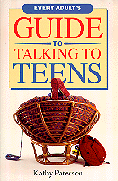


|
Every Adult's Guide to Talking to Teens.
Kathy Paterson. Subject Headings:
Adult.
|
excerpt:
As adults, many of us have (thankfully) forgotten the intense periods of self-doubt, anxiety, and despair that accompany this period of growth. When we attempt to solve an issue that arises with an adolescent, whether it be in the classroom or in the home, we do so from our adult perspective, based on our experiences and our desire to help. What we sometimes forget is that the adolescent also has his or her own perspective that needs to be heard and addressed before the issue at hand can be dealt with effectively.
 Kathy Paterson is a junior-high teacher with twenty years of experience
dealing with the ups and downs of adolescence. She addresses teachers,
parents, and youth workers in her book, and offers them frank advice on
the whole range of problems that arise during this period of great change
in a young person's life. Examples from her years of teaching illustrate
nearly every issue she discusses.
Kathy Paterson is a junior-high teacher with twenty years of experience
dealing with the ups and downs of adolescence. She addresses teachers,
parents, and youth workers in her book, and offers them frank advice on
the whole range of problems that arise during this period of great change
in a young person's life. Examples from her years of teaching illustrate
nearly every issue she discusses.
Recommended.
Harriet Zaidman is a Winnipeg teacher/librarian.
To comment on this title or this review, send mail to cmeditor@mts.net
![]()
Copyright © 1996 the Manitoba Library Association.
Reproduction for personal use is permitted only if this copyright notice
is maintained. Any other reproduction is prohibited without permission.
Published by
The Manitoba Library Association
ISSN 1201-9364
 Go back to CM Welcome page
Go back to CM Welcome page
 Go back to Table of Contents for this Issue
Go back to Table of Contents for this Issue